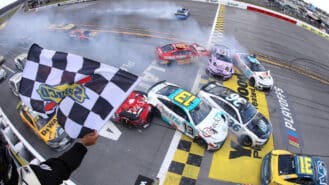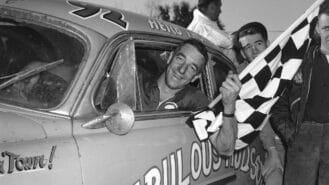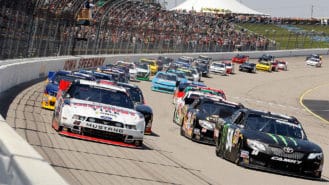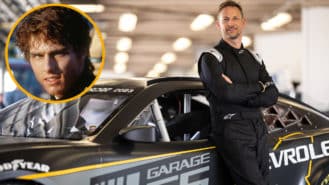
NASCAR: Full Speed review – Can Netflix series avoid going round in circles?
NASCAR has aimed big with its new Drive to Survive Netflix imitator Full Speed: can the docudrama match its lofty ambitions?
NASCAR kicked off its season at Daytona with the Budweiser Shoot-out non-points race on Saturday night which was won by Kevin Harvick and pole qualifying on Sunday for next weekend’s Daytona 500. Times are expected to be tough in NASCAR this year although no fewer than 55 cars made qualifying runs last Sunday for the 42 places in the 500’s field.

One example of NASCAR’s difficult economic times is the merger between Chip Ganassi’s team and Dale Earnhardt Incorporated. Two, three-car teams have become one, four-car team with a few hundred jobs going by the wayside in the process. But Martin Truex and Juan Pablo Montoya showed the merged team’s potential last Sunday as Truex beat everyone to the pole, averaging 188.00 mph, while Montoya qualified fourth only a few hundredths of a second slower than his new team-mate.
Montoya is excited about the new season. The Ganassi-DEI merger has resulted in Montoya switching from Dodge to Chevrolet cars and engines and he believes the move will help him turn the corner and become a regular contender to win races.

“You look at the last half of last season and we got better and better on most tracks,” Montoya said. “We were getting there and I think with DEI’s stuff and Chevrolet, we’ll be even stronger.”
Montoya says NASCAR is all about racing and that’s why he’s there. “If you want to drive the most advanced technical car in the world you drive a Formula 1 car,” Juan remarked. “But if you want to do racing you come to NASCAR. That’s the way I see it. Are the cars the most advanced? No. Are the tyres the best tyres? No. But it brings a lot of the driver onto the table.

“The cars are very hard to drive and the CoT has made it harder. Look at Joey Logano, he won a Nationwide race last year and he got into a Cup car and couldn’t get out of the way fast enough. The cars are hard to drive, they don’t slow-down, and the tyres go off. It’s all about tyre management and understanding how fast you’ve got to be at the beginning of each run to be good at the end.

“In Formula 1 the engineers can balance the car without you actually having to talk to them. Here, we don’t have the telemetry and data to tell you what the car is doing and to compare drivers. Here, it’s yourself. It puts a lot of emphasis on the driver.”
Montoya points out that learning how to get the best from a NASCAR car’s brakes is much more difficult than it looks. “When you’re driving these cars you feel like you brake and you brake, and they just don’t slow down. It’s amazing. It’s one thing that’s really hard and when you run the bottom of the track you’re going to be harder on the brakes. That’s one of the reasons I run high more than I run the bottom of the track.”
Dealing with the notoriously rapid degradation of Goodyear’s spec tyre further complicates life for a NASCAR driver. “There are so many things to deal with,” Montoya says. “The drop-off in thirty laps – half a stint – can be two seconds a lap. When you slow-down by two seconds you’ve got to find a different way around the track. When you drop two seconds a lap there’s so much in the driver in how you’re going to do it, how you’re going to turn the car, how you’re going to back-off. You’ve got to change and adapt your technique all the time. It takes so much of your mind working all the time, so much finesse. It’s not like in Formula 1 where you’re trying to run every lap exactly the same.”

At Daytona and Talladega carburettor restrictor plates cut horsepower by more than half from a normal output of around 900bhp to 450bhp. This means the two big tracks are driven flat, without lifting, and produces furious races with the cars jammed together in giant packs. It’s all about using the air to best advantage – ‘drafting’ as the technique is known.
“You could drive around Daytona by yourself flat without lifting,” Juan observes. “My mom could come here and do it. You haven’t been here for a year and you go out and go straight to the wall and away you go. But when you get in the draft it’s a whole different story. You are driving your ass off. One little thing happens and the whole line just breaks apart. You never know what’s going to happen.”
Montoya says the fear of accidents doesn’t really both him in NASCAR. “I’ve had so many freaking crashes that were so hard, it’s not even funny. But you don’t hurt yourself! You walk away and you’re racing the next day.
One of the biggest adjustments he’s had to make is learning to understand and appreciate feeling good about some races when you finish twentieth or worse. “Chip told me, ‘You’re going to have to learn that some weeks finishing twentieth is not a bad finish.’ And it’s the truth. There are weeks when you’re running good and you finish fifteenth and you say you suck. But there are some weeks if you finish twentieth and you say it was a good day.
“Of course, I want to win races. We all want to win but part of the process was I needed to learn to drive the cars better and learn to understand the sport better, and it takes time. Of course I want to start winning, but whether you run first or thirtieth you are always racing someone. You’re always in a race and for me, it’s cool. It’s exciting. I really get a kick out of it.”

NASCAR has aimed big with its new Drive to Survive Netflix imitator Full Speed: can the docudrama match its lofty ambitions?

The Hudson Hornet is known for its role in Disney film Cars but the story that inspired it is just as compelling: here's how Herb Thomas raced the legendary car to two NASCAR titles and missed out on a third in controversial circumstances

From Daytona to Maggotts: this summer's Silverstone Festival will host a grid of NASCAR machinery in celebration of a joint 75th anniversary

Jenson Button will compete in three NASCAR Cup Series races this year, as well as at Le Mans in a (modified) stock car. it all stems from watching Tom Cruise in Days of Thunder as a youngster, he says